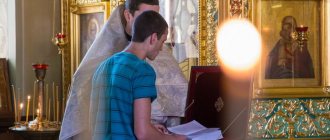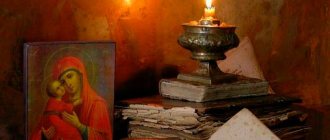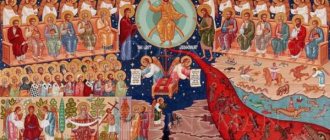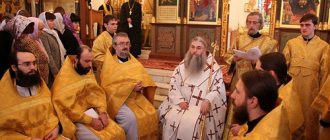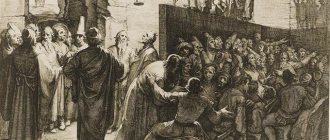Antimins - linen or silk cloth depicting the position of Christ in the Tomb
Antimins - (from Greek anti - “instead” and Latin mensa - “table”) is a board consisting of four corners and made of linen or silk. Particles of holy relics are sewn onto the upper side. Previously, only a cross was depicted on it, but now you can find a scene of the Savior’s position in the tomb, various instruments for executing executions and the four apostles.
Expanded antimension with the signature of the hierarch who consecrated the board
There is always a sponge on the antimind, which is called an antimind. With its help, small particles of the Body of Jesus and particles that were taken from the liturgical bread are collected in special dishes.
This item is also used to wipe the hands and lips of church ministers after receiving Communion. It acts as a symbol of the sponge that was brought to the lips of the Savior Crucified on the Cross.
Antimenses are divided into permanent and portable. The latter were created for camp churches, since there were opponents of the clergy who violated the cathedrals and carried out numerous repressions against believers.
The image on the ancient antimensions was only a cross, and the boards themselves were small in size
Ancient antimensions were performed by the priests themselves, who delivered them to the hierarchs for consecration. The images featured a variety of patterns, but in the 17th century. in Russia they began to produce monotonous boards. Later they began to produce antimensions, which were printed in a typographical way and depicted the position of Christ in the Tomb.
Orthodoxy. Dictionary-reference book
antimins
(from the Greek “in place of the throne”) is a quadrangular board made of silk or linen with sewn-up particles of relics and an image of the position of Jesus Christ in the tomb, the instruments of His execution and the four evangelists in the corners. The antimension bears the signature of the bishop who consecrated it, and also indicates where, when and for which church this consecration took place. The antimension is anointed with holy myrrh and unfolded only at a certain moment in the service, at the end of which it is rolled up in a special way and stored in a special plate - iliton. The antimension is an integral part of the altar, without which the liturgy cannot be celebrated. Moreover, in its meaning, the antimins is equal to the throne. When consecrating a temple, one or more antimensions are placed on the altar and are consecrated along with it. Moreover, in the prayer for the consecration of the throne, the antimensions are called altars on which the bloodless sacrifice of the Eucharist should be performed. Thus, in the consciousness of the Church, the fixed altar in the altar of the temple and the movable antimins are identified. This identification arose in ancient times, when, in connection with the persecution of Christians, portable altars-antimensions appeared, where the relics of the holy martyrs were placed.
Read also: Sea wave color in the interior
In ancient times, the antimension was used instead of a table, but now the liturgy is not celebrated without it
Antimensions in the Orthodox Church are an integral part of church services, without which not a single liturgy is celebrated. It is on them that the consecration of the Holy Gifts is performed.
Antimens
an integral part of any of their church services
As the saint of the Russian Orthodox Church Simeon of Thessalonica said, on the antimensions “everything is done that is done at the divine meal (Liturgy). When necessary, at the discretion of the bishop, they, completely sanctified, are sent to places where there is no altar [throne], and the divine rite of the Mysteries is performed on them.”
The plate is considered the so-called “bishop's letter”, on which the signature of the priest who consecrated and taught this plate is left.
In the photo, the bishop has arranged the Holy Gifts for consecration and is ready for the liturgy
In Rus', antimensions in the Orthodox Church were initially used instead of a throne (a table whose location was in the center of the altar), previously illuminated by the patriarch.
Only towards the end of the 17th century did it become mandatory to have an antimension on the “holy table”, even if it had been consecrated in advance by the bishop. Now this item of church rite, closed, is always on the throne of the Orthodox Church under the Gospel and is dressed in an iliton - a large cloth.
The inscription on the antimension contains:
- The date of its consecration
- Dedication of the temple (throne) for which this antimension is consecrated
- Name of the bishop who taught the antimension
- In the old days, the name of the secular ruler (prince, king), in whose area there was a temple for which the antimension was intended, was also imprinted on the antimension. The name of the ktitor (main benefactor) of the temple could also be indicated.
Holy relics are necessary in order not to forget about the ancient Christians
In order to use the antimension for its intended purpose, you need to perform a small ceremony. The saint moistens it with red wine combined with rose water, anoints it with holy myrrh and places holy relics in it.
All this is necessary in order to preserve the memory of the ancient Christians who built churches and held services at the tombs of the great martyrs.
It is prohibited to consecrate antimensions without placing holy relics on them.
In case of violation of the prohibition by the bishop, “let him be deposed, as if he had violated Church Tradition.”
The veneration of holy relics occurs because Jesus Christ takes on the image of human essence. Thus, the Son of God strengthened the significance of the human body, and then he sat down at the right hand of the Father not only as a real God, but also as a real Man - in the human mental-physical essence.
The placement of holy relics is an invisible thread that connects the earthly temple with the heavenly temple
When holy relics are placed in the antimension, many priests find in this process a tangible thread connecting the earthly temple with the heavenly temple. The earthly Orthodox army is drawing closer with God's blessing into one part - the Body of Christ.
In Him, Christ, the Most Holy Theotokos with the heavenly Angels are with us in one magnificent doxology of love, which is the Divine Liturgy.
When the antimension is consecrated, the same sacred actions are performed over it as are done over the saint. throne. For example, the same rituals are performed, the same words and prayers are pronounced, and similar chants are sung.
Features of use
The antimension is located in the temple, on the throne. During non-liturgical times, it is wrapped in a cloth - iliton
, which protects this shrine from pollution. Iliton symbolizes the sudar - the headdress that was put on the Savior during burial. Until the 17th century, this custom was practiced in Greece, but in Russia the antimins was kept unfolded, attached to the throne or to its vestments.
Only a person invested with holy orders has the right to touch the antimension: a bishop, priest or deacon. In this case, the deacon must be in full vestments, and the priest or bishop must be in vestments and stole.
The antimension is used during the celebration of the Liturgy: a chalice and paten are placed on it at the appointed moment of the service.
An indispensable accessory for antimining is a special antimining sponge.
, with which crumbs of the blessed prosphora are collected from him.
In special circumstances, worship can be performed on the antimension in the absence of a throne or even a temple. Thus, during the years of persecution of faith, some priests served the Liturgy at home and even in nature. "Teaching news"
- the ancient text regulating the service indicates that if there is a danger of destruction of the temple during the already begun Liturgy (for example, during an earthquake), the priest can remove the antimension and sacred vessels from the altar and finish the service in a safe place.
Iliton performs a practical function: particles that fall on it can be easily removed
The vessels for Communion stand on the antimension on top of the iliton, which is unrolled only for the celebration of the liturgy.
Iliton is a red linen or silk liturgical cloth, which is kept on the “holy table.” It is no coincidence that this color was chosen. It symbolizes the blood of Jesus Christ shed for people. Iliton is necessary to wrap antimins.
Iliton is unfolded only during the Divine Liturgy. Also on it are vessels with the consecrated Holy Gifts (Eucharistic bread and wine).
The oriton for the antimension must be larger in size and must be consecrated by the bishop.
The use of the orithon for worship is that it is spread out on the “holy table” shortly before the Holy Gifts are placed on it and folded back at the moment when, at the end of the liturgy, the Eucharistic Gifts are removed from the throne.
In this way, reverence for the Holy Gifts is expressed. The stretching of iliton also has a practical orientation. For example, if particles of the Holy Gifts fall from a liturgical vessel, they will remain on the orithon and can be easily collected, and the deacon can use them at the end of the service.
The fabric used for the production of iliton is predominantly dark red or purple in color, in order to easily detect light particles on it.
The red color of iliton is associated with the blood of the Savior, which he shed for people
Orthodox Encyclopedia
antimins
(translated from Greek means “instead of the throne”) a scarf with particles of relics sewn into it, on which the liturgy is performed. The antimins is consecrated by the bishop with a special rite. It usually has a quadrangular shape and is sewn from silk or linen fabric. On the antimension there are images of the position of the Lord Jesus Christ in the tomb after He was taken down from the cross, and all four evangelists. While the liturgy is going on, the antimension lies on the throne. When the ritual ends, it is wrapped in iliton. The modern antimension arose as a result of the early Christian custom of celebrating the liturgy at the graves or tombs of holy martyrs. Later, the number of temples increased, and pieces of relics began to be placed into the altar of each of them. Then, in the 8th–9th centuries, the custom arose of sewing particles of relics into fabric and placing it on top of the throne.
In Greek churches, the holy relics of martyrs are sewn into the antimins
In the Greek Church, the custom remained of sewing the holy relics of martyrs into the antimension, as well as using it from the Ruling Priest to conduct services in a church with an unconsecrated altar.
The boards that were used in Greek churches were made, as Simeon of Thessalonica said, from linen, on the edges they had drawings depicting the evangelists and the inscription: “the altar of the saint, the name of the rivers who officiated from the patriarch, the name of the rivers, the month of which and in the summer.”
The production, preservation and transfer of antimensions was the obligation of what was popularly called the “chief of the antimensions.”
In Western countries of the Orthodox tradition, the role of the antimins is played by the corporal, usually made of white fabric.
Corporal
analogue of the antimins in the Orthodox tradition of Western countries
The antimension is a significant detail in the celebration of the Divine Liturgy in the Orthodox world, and for many centuries this tradition has been preserved, although it has undergone some changes.
Despite this, some clergy consider the use of board, instead of liton, to be incorrect.
By leaving a comment, you accept the user agreement
Application in the Orthodox tradition
Initially, the antimension was used as an alternative to the traditional throne: this was especially true in those days when the first Christians prayed secretly and did not have the opportunity to build churches in which they could conduct full-fledged services that complied with all the canons.
In the Church, the use of antimensions has become mandatory since 1675
In Rus', the antimins was also often used instead of the throne, until at one of the Councils in 1675 it was decided to use the throne and antimens together. Since then, the antimension has taken its place on the throne next to the Gospel. In those times when the board is not needed for a church service, it is wrapped in oriton.
